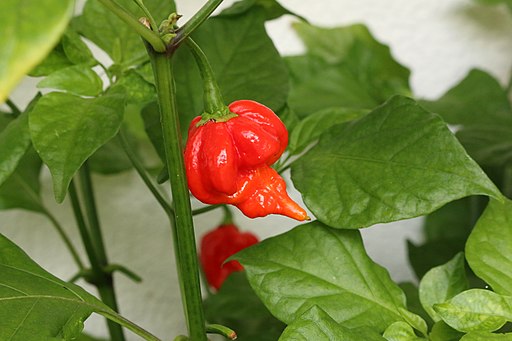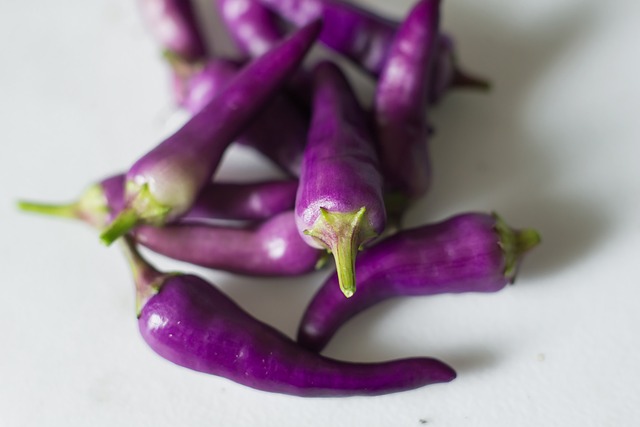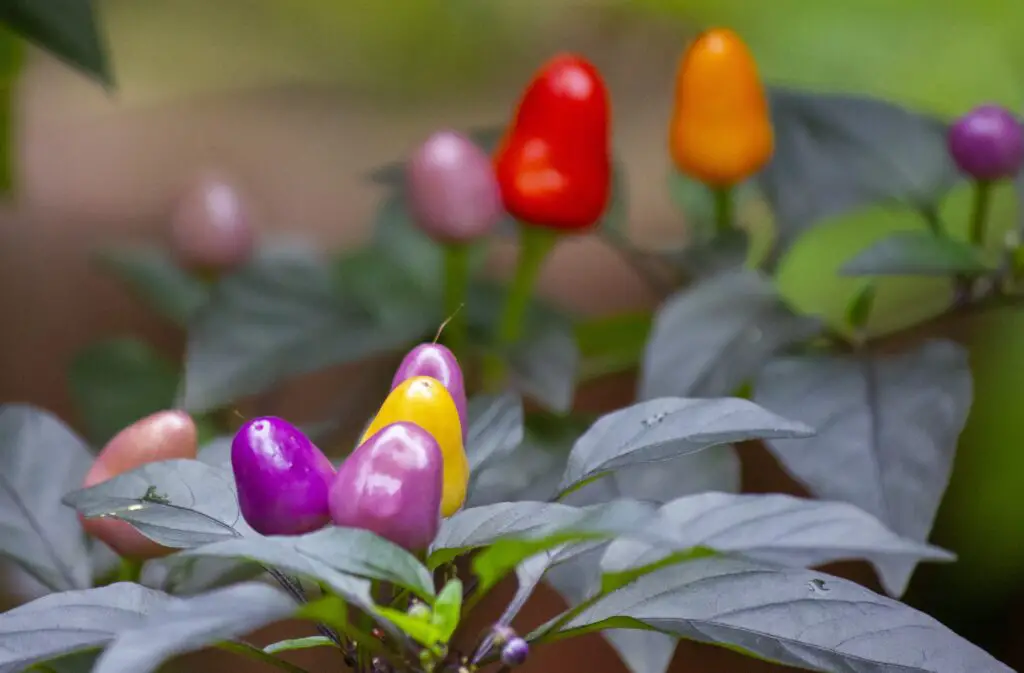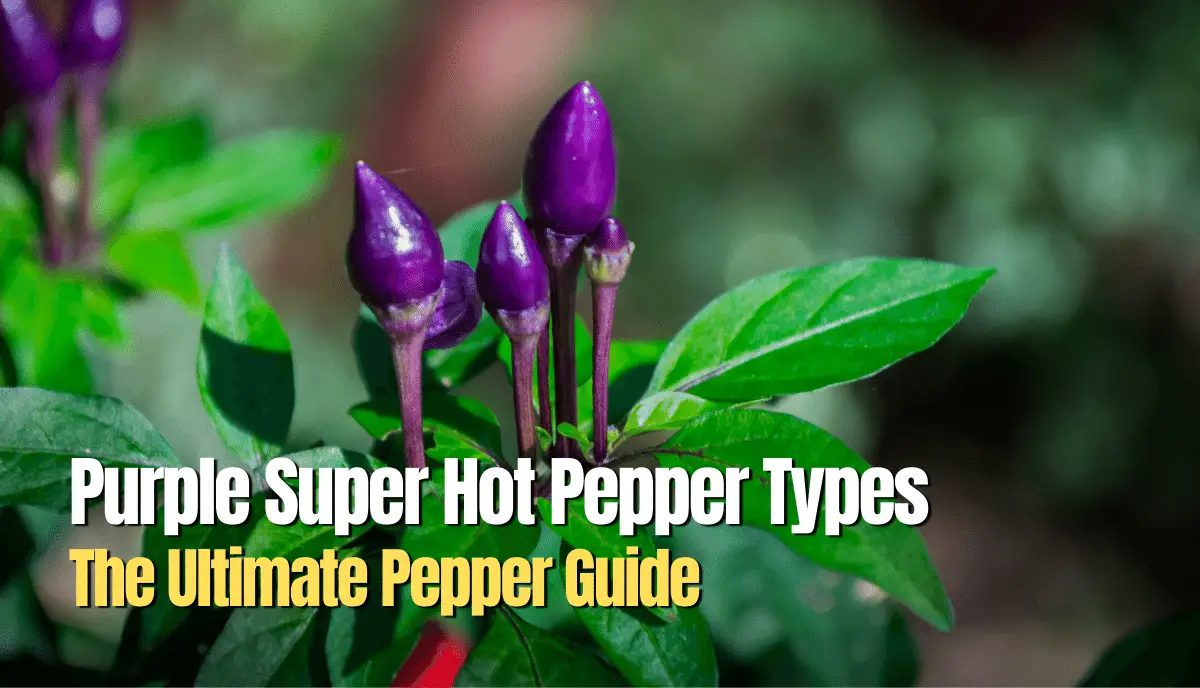Purple super hot peppers are gaining popularity among spice enthusiasts and gardeners. As their name suggests, these unique peppers not only boast a stunning purple hue but also pack a fiery punch.
This ultimate guide was created to provide valuable information on the various purple super hot pepper types available, as well as tips and tricks for growing and enjoying these flavorful and aesthetically pleasing peppers.
Types of Purple Super Hot Peppers
Purple Bhut Jolokia Ghost Pepper

Purple Bhut Jolokia, also known as ghost pepper, is an extremely hot purple pepper. It has a unique, fruity flavor with an intense heat level. The plant itself is attractive, with dark foliage and purple flowers.
Purple Reaper
Purple Reaper is a beautiful and fearsome pepper hybrid that combines the heat of the Carolina Reaper with a deep purple hue. It has a fruity, smoky flavor and is considered one of the hottest purple peppers in the world.
Purple Trinidad Scorpion

The Purple Trinidad Scorpion is a rare purple variety of the scorching Trinidad Scorpion pepper, which boasts a heat level similar to that of the Bhut Jolokia. This pepper is characterized by its wrinkled skin, pungent aroma, and fruity taste.
Purple Jalapeño Pepper
The Purple Jalapeño pepper is a vibrant variation of the classic green jalapeño. It is milder than most of the purple peppers on this list, with a heat level between 2,500 and 8,000 Scoville units. Apart from the color difference, purple jalapeños have a similar taste to their green counterparts.
Purple Cayenne Peppers

Purple Cayenne peppers are a striking, purple-colored version of the conventional red cayenne. They have a heat rating of 30,000 to 50,000 Scoville units, providing a moderate level of heat. Their flavor is much like that of the red cayenne pepper, but with a slightly milder taste.
Pretty in Purple Pepper
Pretty in Purple pepper is a fairly small, ornamental pepper with vibrant purple and dark green leaves. The tiny conical fruit appears in shades of purple before ripening to orange and red. While decorative, these peppers still pack a spicy punch.
Peruvian Purple Pepper
Peruvian Purple pepper is an ancient Peruvian variety characterized by its deep purple leaves, flowers, and small, conical-shaped peppers. This versatile pepper adds vibrant color to any dish, and its heat level is moderate, making it approachable for most palates.
Murasaki Purple Peppers
Murasaki Purple peppers are a mid-level heat pepper variety, slightly hotter than the Jalapeño. They feature a stunning purple hue and subtle, earthy flavor. These peppers are perfect for spicing up many dishes.
Purple Cluster Pepper
Purple Cluster peppers are an ornamental variety bearing small purple fruit with a mild heat level. Named for their tightly clustered habit, they grow close together, creating a visually striking display on the plant.
Purple Tiger Pepper
Purple Tiger peppers are a variegated pepper variety with purple and green leaves. The small, elongated fruit begins as striped purple and green before ripening to red. With a moderate heat level and fruity taste, these peppers are as versatile as they are beautiful.
Bolivian Rainbow Hot Pepper

The Bolivian Rainbow hot pepper is an eye-catching ornamental variety that produces small, bullet-shaped fruit with a striking color transition from dark purple through yellow and orange to finally red. This pepper delivers a spicy kick that’s perfect for adding heat to various dishes.
Purple Prince Pepper
Purple Prince pepper is distinguished by its deep purple foliage and small, round, dark purple fruit. The pepper is mildly hot, with a sweet and slightly tangy taste.
Purple Bell Pepper

The Purple Bell pepper stands out as a unique, no-heat pepper, with a thick flesh and sweet taste. This colorful pepper variety is perfect for fresh eating or any recipe that requires bell peppers.
What’s the Hottest Purple Pepper?
When it comes to the heat of purple cayenne peppers, the Purple Haze Pepper stands out as one of the hottest. Capsaicin levels in peppers are measured using the Scoville Heat Units (SHU) scale, and the Purple Haze Pepper can rate between 30,000 to 50,000 SHU, making it significantly spicier than some jalapeños.
Another noteworthy cayenne purple pepper is the Buena Mulata Pepper, known for both its beauty and heat. Originating from Cuba, this pepper boasts a heat level of around 10,000 to 30,000 SHU. Its fruity and smoky flavor accompanies a heat that can linger on the tongue, making it quite a sensation for chili enthusiasts.
The Violet Jalapeño, though not at the higher end of the heat spectrum, provides a heat level similar to that of a green jalapeño. With SHU ratings between 2,500 to 10,000, it is the mildest among the hottest purple peppers. Nonetheless, it remains a popular choice for those looking for a purple pepper with a milder kick.
Here is a table for quick comparison of the mentioned purple peppers:
| Pepper | Scoville Heat Units (SHU) |
|---|---|
| Purple Haze Pepper | 30,000 to 50,000 |
| Buena Mulata Pepper | 10,000 to 30,000 |
| Purple Jalapeño | 2,500 to 10,000 |
It is essential to keep in mind that individual experiences with heat may differ depending on factors such as pepper variety and individual tolerance. As such, it’s crucial to approach tasting new purple peppers with caution and pay attention to the SHU ratings to determine which pepper may be best suited for your preferences.
Growing Purple Super Hot Peppers
Ideal Climate Conditions
Purple Super Hot Peppers thrive in warm, sunny conditions. These peppers prefer temperatures between 70-90°F (21-32°C) during the day and 60-70°F (16-21°C) at night. They require a minimum of 6 hours of direct sunlight daily.
To increase the chances of success, start the seeds indoors 6-8 weeks before the last frost in your area, and transplant them outdoors only after the soil has warmed up.
Plant Care and Maintenance
To ensure healthy growth, follow these guidelines:
- Soil: Choose well-draining, fertile soil with a pH level between 6.0 and 6.8. Add compost or aged manure to improve the soil quality.
- Spacing: Plant the seedlings 18-24 inches (45-60 cm) apart in rows that are 24-36 inches (60-91 cm) apart.
- Watering: Water the plants consistently, providing about 1-1.5 inches (2.5-3.8 cm) of water per week. Ensure the soil remains moist but not waterlogged.
- Mulching: Add a layer of organic mulch around the plants to help retain moisture, suppress weeds, and regulate soil temperature.
- Fertilizing: Apply a balanced fertilizer every 3-4 weeks, following the package instructions.
- Pest Control: Regularly inspect the plants for any signs of pests or diseases. Treat with appropriate organic or chemical solutions if necessary.
Harvesting and Storing
Purple Super Hot Peppers are usually ready for harvest 70-90 days after transplanting, depending on the variety. Here are some tips for harvesting and storing:
- Signs of Maturity: Harvest the peppers when they reach their full size and develop a deep purple color. The skin should be firm and glossy.
- Harvesting: Use pruning shears or a sharp knife to cut the peppers from the plant, leaving a short stem attached.
- Storing Fresh: Store the fresh peppers in a cool, dry place, such as a cellar or refrigerator, for up to 2 weeks.
- Preserving: To extend their shelf life, you can dry, pickle, or freeze the peppers. Dried peppers can be stored in an airtight container for up to a year, while pickled or frozen peppers can last several months.
Culinary Uses and Pairings
Purple super hot peppers, known for their vibrant color and intense heat, have a range of culinary applications. In this section, we explore the traditional recipes, creative dishes, and complementary ingredients that showcase these captivating peppers.
Traditional Recipes
Purple super hot peppers make a strong statement in traditional dishes. Here are a few examples:
- Purple Pepper Salsa: Combine purple peppers, tomatoes, onions, garlic, cilantro, lime juice, and salt for a colorful and spicy twist on classic salsa.
- Purple Pepper Hot Sauce: Simmer purple peppers, garlic, and vinegar, then blend to create a vibrant, flavorful hot sauce.
Creative Dishes
Chefs can get creative with purple super hot peppers by incorporating them into new and unexpected dishes:
- Purple Pepper-infused Oil: Steep purple peppers in a neutral oil, such as grapeseed or vegetable oil, to create a spicy, colorful oil for drizzling over dishes.
- Purple Pepper Ice Cream: Create a sweet and spicy frozen treat by adding minced purple peppers to a vanilla ice cream base before churning.
Complementary Ingredients
Purple super hot peppers can be paired with various ingredients to elevate their flavors:
- Fruits: Melons, peaches, and mangoes pair well with the heat of purple super hot peppers in salsas and jams.
- Proteins: Chicken, shrimp, and tofu can be marinated in a blend of pureed purple peppers, garlic, and oil for a fiery kick.
- Grains and legumes: Spicy purple pepper flakes or powder can be added to rice, beans, or lentil dishes for an extra layer of flavor and heat.
Frequently Asked Questions
When to pick purple peppers?
Purple super hot peppers reach their ideal maturity between 70 and 90 days after transplanting. It’s essential to harvest them when they have a deep purple color, as this indicates their peak flavor and heat level.
Keep an eye on the fruits as they ripen, and make sure to pick the peppers before they start to wrinkle, which signals overripe conditions. To harvest, cut the stem ¼ to ½ inch above the fruit using a sharp pair of gardening shears.
Growing in aerogarden?
Purple super hot peppers can indeed be grown in an aerogarden system. These hydroponic systems are known for their efficiency in growing plants by providing an optimal balance of water, nutrients, and light.
Before planting, make sure to properly clean and sanitize your aerogarden to prevent any contamination or diseases. Follow the manufacturer’s instructions for planting the peppers, keeping in mind that these plants require a good amount of space for proper growth – one pepper plant per pod should suffice.
Monitor the water level carefully, maintain a consistent nutrient schedule, and adjust the light height as the plants mature to achieve the best results.
Murasaki vs Purple Prince?
Murasaki and Purple Prince peppers are two popular purple super hot pepper varieties with distinctive qualities. Murasaki peppers, also known as Japanese purple peppers, are characterized by their elongated shape, slightly wrinkled skin, and sweet, mildly spicy flavor. They are often used in Asian cuisine and make a colorful addition to salads and stir-fries.
In contrast, the Purple Prince pepper is easily recognized by its bell-shaped appearance and smooth skin texture. Its flavor is sweet with a hint of spiciness, making it versatile for culinary purposes. Purple Prince peppers can be stuffed, roasted, or included in a variety of dishes to add color and depth of flavor.
Final Thoughts
In conclusion, purple super hot peppers offer a unique combination of striking aesthetics and fiery heat. While the Purple Haze Pepper is often regarded as one of the hottest purple peppers, real-life examples like the Carolina Reaper, with its intense heat, push the boundaries of spiciness.
Whether you’re a spice enthusiast or a gardener looking to add vibrant colors to your garden, exploring the world of purple super hot peppers can be an exciting and flavorful journey. Just remember to approach these peppers with caution and consider your personal heat tolerance when venturing into the realm of fiery flavors.

